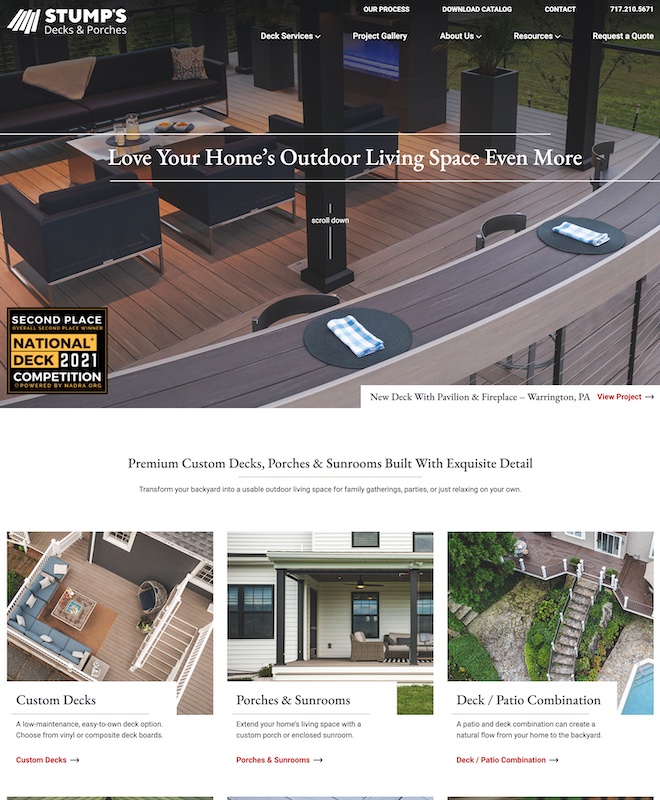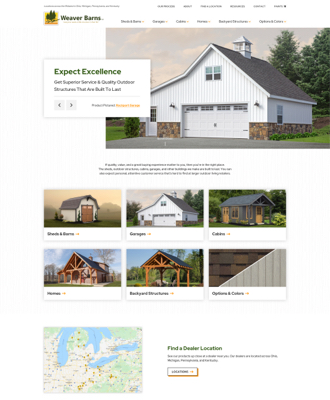Measuring the ROI of a New Website
admin | Aug 25, 2022
Cost is one of the most common objections small business owners and managers have about building a new website. Even if their website looks old & outdated, they are concerned about the upfront investment in rebuilding the website.
What they often don’t realize is that their current website is costing them money – in some cases a lot of money. And unlike a new website, which is an investment that should pay dividends in terms of better rankings and more leads, the money their current website is costing looks more like wasted ad dollars and lost productivity from their team.
5 Ways Your Website Is Costing You Money
After talking with hundreds of local small business owners about their websites, here are some of the most common ways your website is costing you money.
1. Lost Rankings
Search engine results are not static; they can and do fluctuate on a regular basis. The website that launched you to #1 rankings 5 years ago may not be able to keep up with competitors who have a brand new website.
Your website has a direct impact on how your company appears on Google – both in organic search and through your Google Business profile. You already know that the words on your website and the links to your website have an impact on search visibility, but it is often the hidden code on your website that can make or break your rankings.
Things like the code base of your website, your site load speed, and the number of plugins you rely on can all affect how your website shows up on Google. And unlike missing keywords, these are much more costly to fix. In most cases, it makes more sense just to rebuild your website.
Decreasing rankings means less traffic and fewer leads generated by your website. Instead, these potential customers will visit your crosstown competitors who are climbing ahead of you on Google. Or, you’ll need to pay more money for Google Ads to appear at the top of searches you once dominated.
2. Lost Leads
Websites that aren’t designed with user experience (UX) and conversion in mind are a great way to waste money. You can be paying thousands of dollars each month running Google Ads to send potential clients to your website – only to provide a poor experience.
A website that is confusing, hard to navigate, or does not provide the right information will cause potential customers to get frustrated and not take action on your website – like calling you, filling out a form, or booking an appointment. Instead, they will visit a website with less friction, likely a competitor’s, and get the information they are looking for.
3. More Time Is Needed for Updates
Websites built on older web platforms can take longer to update even basics like photos, content, and information. Making major adjustments – like the main navigation bar or adding new services – can take 3x as long for a seasoned developer to make as it would on a newer WordPress website.
Even if your website is built on WordPress, if it was built more than 5 years ago, there are likely inefficiencies in how it was built. WordPress development is always improving and making things simpler. So newer WordPress websites are more user-friendly for updating and maintaining content.
4. Increased Ad Spend
Did you know you pay more per click if you are running ads to a poorly built landing page?
Digital advertising platforms want to make sure users are seeing relevant ads that aren’t misleading or a poor experience. To measure user experience, each ad platform has a rating system (Google Quality Score and Facebook Quality Ranking) that evaluates your ad copy, creative (images, video, etc.), targeting, and even the landing page.
If your landing page is slow, not mobile friendly, or has content that doesn’t align well with the ads you are running, you will get a lower quality score. A lower quality score means your ads will cost more to run. Unfortunately, fixing this is not always as simple as updating the landing page; sometimes the entire website’s code base needs to be overhauled.
5. Increased Risk
If you know anyone whose website has been hacked, you understand the importance of taking reasonable steps to keep a site’s security up to date. Most older websites rely on free plugins from third-party developers, or out-of-date CMS that are missing critical security patches. This all means that older websites frequently have security vulnerabilities that hackers can use to take over your site and your customer data. It’s just a matter of time until you are spending a lot of money fixing these issues while losing valuable uptime of your website.
Another liability of older websites is due to accessibility. There is a rising number of legal cases where small businesses are being held liable for not having an ADA-compliant website. And there are entire law firms specializing in website accessibility, so you know these lawsuits will continue.
The third risk of an older site is losing the ability to update your website. If your website is more than 5 years old, it’s probably changed a bit over that time. New sections are added, additional functionality, and hacks that your team has put together to make things work. What happens if your team leaves and you hire someone else to take their place? Will they be able to learn all the workarounds and hacks to keep the site updated? Or will it lead to frustration and dissatisfaction for your new team member?
At the speed that technology evolves, your 5-year-old website is comparable to a 25-year-old car. It still runs, but do you want your business to depend on it? Outdated websites are like ticking time bombs, ready to cost their owners a lot of money as they scramble to save data and do a fast rebuild.
Recent Website Upgrades With a High ROI
Here are some recent website builds and the benefits these businesses are now enjoying:
Stump’s Decks
Stump’s Decks is an award-winning deck builder serving southeastern PA. While their website was built on WordPress, it was several years old and showed some age. The design was older and reflected their older branding, and the website did not effectively highlight the high-end projects they are now building.
Their new website includes their updated branding, displays their projects in an easy-to-browse gallery, and prominently features professional photography so that the quality of their work stands out.
Key metric: The new site has seen a 35% increase in organic search traffic in its first 3 months compared to the same period the previous year with the old website.

Weaver Barns
Weaver Barns is a shed and outdoor structure manufacturer in the Midwest. Their old website was built on WordPress but was difficult to update and maintain.
Their new website features a clean, modern design that showcases the variety of their structures. More importantly, the backend of WordPress is completely transformed, making it much easier for the Weaver Barns team to add products, update features, and make wholesale changes to their website.
Key metric: The new site saw a 790% increase in shed quote requests in its first few months after launch compared to the previous year.

[Confidential] Regional Pest Control Company
This regional pest control company was looking to quickly expand into new markets and wanted a better website to do this. Their new website was designed from the ground up to increase appointments, while also introducing their brand and stellar reputation to new audiences.
Key metric: In the first three months after launch, the new site saw a 500% increase (480 vs. 80) in scheduled service appointments compared to the previous 3 months with the old website.
[Confidential] Landscape Company
This landscaping company was looking to move from a quickly built website to one with a more professional feel. Their new website provides a better reflection of their services, highlights their recent projects, and moves visitors into booked appointments.
Key metric: In the first 3.5 months after launch, the new site saw a 92% increase (482 vs. 252) in contact form completions compared to the previous 3 months with the old website.